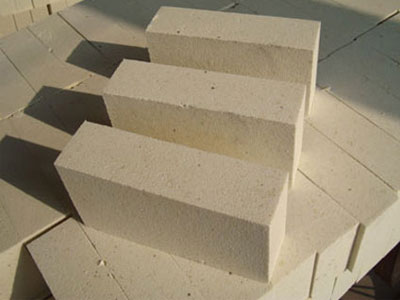Lightweight silica bricks are also called silica heat insulation bricks. A lightweight refractory material with a silica content of more than 91% and a bulk density of less than 1.2g/cm3. The refractoriness and load softening temperature are not much different from ordinary silica bricks with the same composition. However, due to the large number of pores, the compressive strength, slag resistance, and corrosion resistance are not as good as ordinary silica bricks, but the thermal shock resistance has been improved.
Finely crushed silica is used as raw material, and its critical particle size is usually not more than 1mm, and the particles smaller than 0.5mm are not less than 90%. Add flammable substances to the ingredients or use the gas generation method to form a porous structure, and then it is made by firing. It can also be made into non-fired products. It is mainly used in various parts of the kiln that require heat insulation or lightening of self-weight without direct contact with the melt, without the action of corrosive gases, and without being subjected to sudden temperature changes. It is used at high temperature and cannot be in contact with alkaline refractory materials. According to different materials, the maximum operating temperature is 1200~1550℃.
Lightweight silica brick is a very special material, mainly used in glass industry and steel industry. In most cases, lightweight silica bricks and dense silica bricks are used as part of the structural layer. It is commonly used in the glass kiln industry, mainly for the insulation of the kiln vault, thereby reducing heat loss and increasing the efficiency of the melting process. In the steelmaking industry, lightweight silica bricks are used for the light weight of walls and domes of hot blast furnaces.
1. Lightweight silica bricks are used in the glass industry – heat insulation of furnace vaults
During the glass melting process, very high temperatures are reached in the convex lower part of the vault. Depending on the type of glass, the temperature is around 1600°C. Lightweight layers are usually designed in two or more layers.
Lightweight silica bricks are mainly exposed to these temperature loads. The same or similar expansion properties are expected for the single layers of the vault (structural and lightweight layers). Silica bricks with a bulk density of 1250kg·m-3 or 1000kg·m-3 can meet the requirements of the dense layer. The next layer uses silica bricks with a bulk density of 800Kg·m-3 or 600kg·m-3.
Lightweight silica bricks can be freely coded on the furnace arch, or bonded with silica fire clay. There is no chemical load during the furnace service period (several years). Lightweight silica bricks are mainly used because the chemical and mineral composition is similar to the dense silica bricks used for working linings.
2. Lightweight silica bricks are used in the steel industry – hot blast furnace
The hot blast stove is often used for hot air (called blast furnace blast), which is connected to the air extractor of the blast furnace. According to the shape and location of the hot blast stove, the temperature range is between 1000 ~ 1300 ° C, and the hot air is 2300 ~ 6500m3 min- 1 range.
This entails calculating a comparison between hot blast stoves (with different component sizes and usage locations) and glass furnace vaults at different levels and loads, focusing on thermomechanical properties. For lightweight layers, the bulk density used is 1250kg·m-3 or 1050kg·m-3 (mainly due to their higher strength).



